Can linear motors replace ball screws?
A reader of Control Engineering recently asked, “When I hear the sound of a ball screw that’s beginning to fail on a CNC milling center, I have to wonder: Isn’t there a better way to get that kind of linear movement? Are there other technologies?” We put that question to John Meyer at Siemens Motion Control Group, and he suggests linear motor technology.
A reader of Control Engineering recently asked, “When I hear the sound of a ball screw that’s beginning to fail on a CNC milling center, I have to wonder: Isn’t there a better way to get that kind of linear movement? Are there other technologies?” We put that question to John Meyer at Siemens Motion Control Group, and he suggests linear motor technology.
Linear motors have not been part of the progression of modern machine design that has seen quantum leaps in control technology, says Meyer. Rather, modern machines still, for the most part, use slide propulsion that was designed in your grandfather’s day. We have gone from tape-driven NC machines driven by dc servo motors and ball screws, to sophisticated CNC controls that can take a CAD file and produce a machine program at the touch of a button, right on the machine. To drive the slides on this modern machine, we have progressed to ac servo motors driving ball screws. And maybe we also updated the slides from box way to truck and rail, but how are we driving these slides? Servo motors and ball screws.
Linear motors enable maximum precision and dynamic performance in various motion control tasks. These include not only rapid traverse, but slow constant speed traverse of machine heads, spindle slides, tool management systems, part handling devices and more. There are considerable cost savings when various mechanical components are replaced by simple and efficient linear motors. These motors provide a total drive system, offering reliability, precision, high dynamic stability, low maintenance, and improved production time.
What is a linear motor?
The rotary electric motors with which we are so familiar contain a circular electro-magnet called a stator. In a linear motor, the electromagnet is built the same way, only flat as if it were unrolled. The rotor is also built the same way, unrolled or flat. When the electromagnets of the primary are energized, they attract the secondary sections and push the motor along. The more current applied, the stronger the magnetic field and the more force the motor generates.
Visualize a wooden roller coaster at your favorite amusement park. To get the train up the first hill for that “big drop,” we roll to the base of the hill where a chain drive, driven by an electric motor, gearbox, and sprocket, clanks and jerks the train to the top of the hill. Now, imagine a ride a modern roller coaster with linear motors. Feel that sudden burst of acceleration as you leave the station? Enough force can be generated to propel the train over the first hill and through that first scary loop. Booster “shots” of force can be used at various points to maintain the train’s speed, as it rolls through loops and turns never before possible with older designs. Finally, you feel the braking action at the station by a linear motor. What stopped the wooden roller coaster? Remember the guy at the station pulling a big lever?
Linear motors are simple. Two main components, the primary containing electro-magnets and the secondary, with either permanent magnets or magnet-free, drive the moving member. Gone are servo motors, resolvers, tachometers, couplings, pulleys, timing belts, ball screws and nuts, support bearings, lubrication systems, and cooling systems. Gone also are systems that used hollow ball screws with coolant systems for thermal stabilization. Gone are rack and pinion systems that used expensive torque motors and/or gear boxes. Gone also are chain drive systems requiring high torque hydraulic motors with associated power units.
Linear motors are proven, available and economical. As more linear motors are produced, they will become even more economical. In short, it is time for the mechanical systems of these machines to catch up to the control technology.
Author Information
John Meyer is with Siemens Motion Control Group. To help the machine builder in the design and application process, Siemens has developed tools to configure the right size motor for the slide design application. Visit www.siemenscnc.com for more information.
Author Information
John Meyer is with Siemens Motion Control Group. To help the machine builder in the design and application process, Siemens has developed tools to configure the right size motor for the slide design application. Visit www.siemenscnc.com for more information.
Do you have experience and expertise with the topics mentioned in this content? You should consider contributing to our CFE Media editorial team and getting the recognition you and your company deserve. Click here to start this process.


